Introduction
Larger screen with a trendy notch, newer chipset, bigger battery, and a current OS version - it sure sounds like Huawei has ticked a lot of boxes to bring an already successful formula to the year 2019. It's the Huawei P Smart 2019 we're talking about, the follow up to the smartphone that happened to be the star of one of our most read reviews last year.
The P Smart 2019 swaps out the 5.65-inch 18:9 display of last year's model for a larger (6.21-inch) and more contemporary 19.5:9 aspect panel that also has a waterdrop notch - you can't accuse Huawei of not staying on top of trends. In fact, it's even got the latest Android too, 9.0 Pie - few models in the segment can say the same thing.
The 2019 version comes with an updated chipset - the in-house Kirin 710 replaces the 659 of the predecessor bringing a bump in manufacturing process (12nm vs. 16nm). And to go with the improved efficiency, you're also getting an increased battery capacity - 3,400mAh vs. the 3,000 of the original P Smart.
Huawei P Smart 2019 specs
- Body: Plastic body, 155.2 x 73.4 x 8.0 mm, 160g; Midnight Black, Aurora Blue, Sapphire Blue, Coral Red color schemes.
- Display: 6.21" IPS LCD, 1,080 x 2,340px, 19.5:9 aspect ratio, 415ppi.
- Rear camera: Primary 20MP, f/1.8 aperture, 26mm equiv. focal length; phase detect autofocus; secondary 2MP depth sensor.
- Front camera: 8MP, f/2.0 aperture, 26mm equiv. focal length; fixed focus lens.
- OS/Software: Android 9.0 Pie, EMUI 9.
- Chipset: Kirin 710: octa-core CPU (2x2.2GHz Cortex-A73 + 2x1.7GHz Cortex-A53); Mali-G51 MP4 GPU.
- Memory: 3GB of RAM; 32/64GB storage; microSD card slot (hybrid).
- Battery: 3,400mAh (sealed), 5V/2A charging (no Huawei SuperCharge).
- Connectivity: Dual SIM; Wi-Fi a/b/g/n/ac, Bluetooth 4.2; microUSB 2.0, 3.5mm jack.
- Misc: Rear-mounted fingerprint sensor; single, bottom-firing loudspeaker; dual microphones (noise reduction).
Little else has changed in other areas, so the 2019 P Smart comes with what's at first glance the same camera setup - a 13MP primary module with a 2MP depth sensor on the side. The 8MP selfie shooter has been carried over too, but some regions will be getting an alternative 16MP cam on the front - not our review unit, though.
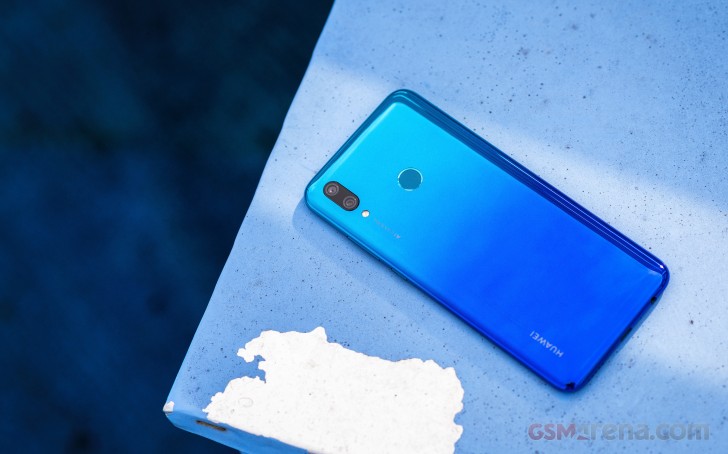
One thing we need call Huawei out for is the missed opportunity to switch to USB-C - the P Smart 2019 still has a microUSB port and that's not very 2019, is it?
We didn't get a strictly retail-grade box, but the contents should include a 5V/2A charger and a microUSB cable to go with it - these two we did get. A pair of earbuds is also part of the retail package. Let's not get too fixated on the peripherals and have a closer look at the phone itself - join us on the next page.
Design and 360-degree spin
The P Smart for 2019 shares little with the original when it comes to looks and it shows how quickly design trends change. On the other hand, it borrows a lot of its design cues from the current Huawei lineup, making it resemble the company flagships of the day.
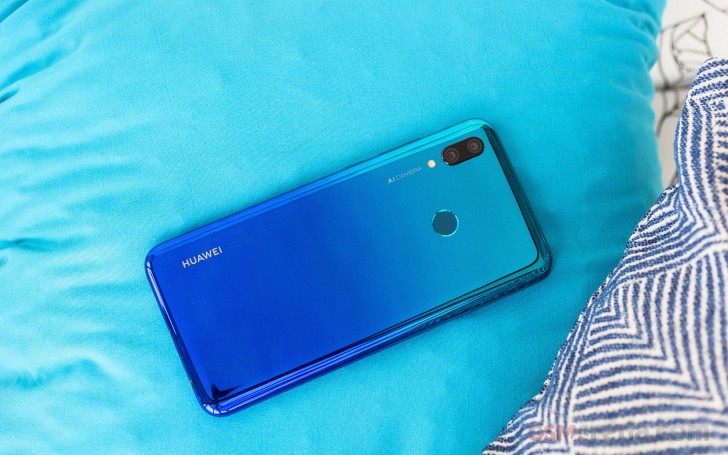
That includes the dual-tone paint job on the back that we've been fans of since the P20 - of course, not the exact same choice of colors, but the gradient is there. That's one of the color options you can get - the other three are single-color and we especially like the red, but it remains second best to the gradient variant we have for review.
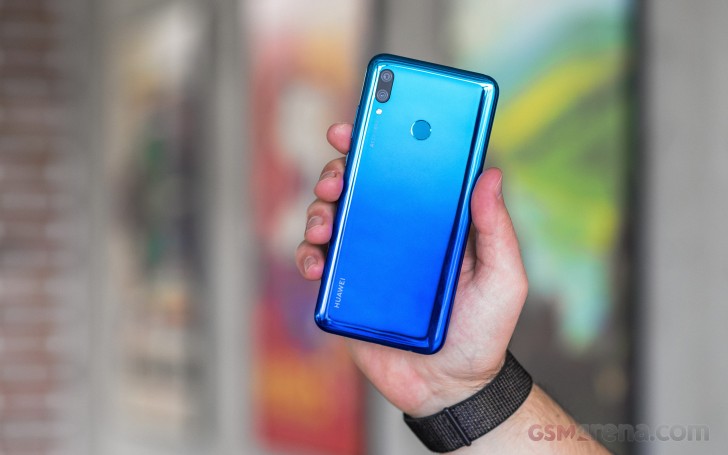
Regardless of color, the rear panel is made of plastic and that's both bad and good. For one, the P Smart 2019 is quite prone to scratching - our review unit wasn't brand new when it arrived so we can't be sure just how much abuse it's seen, but the reality is that its back wasn't in pristine condition.
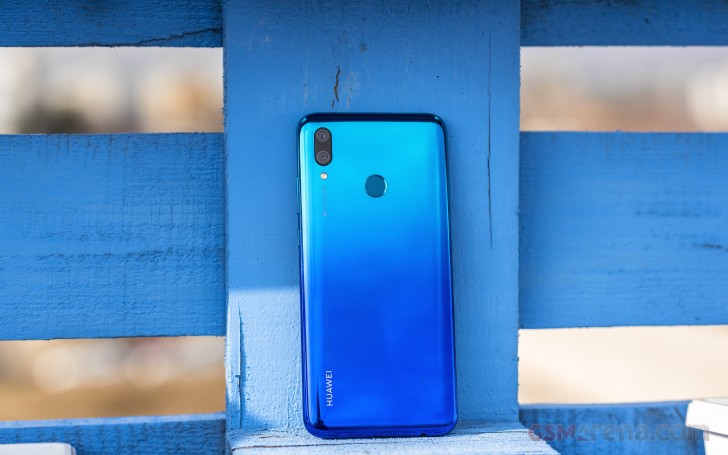
On a positive note, the choice of materials makes the P Smart 2019 one of the lightest phones in its segment. At 160g it's noticeably lighter than competitors that are typically in the 180s. Some people associate weight with quality and those may call the P Smart 2019 plasticky. Well, it is made of plastic.
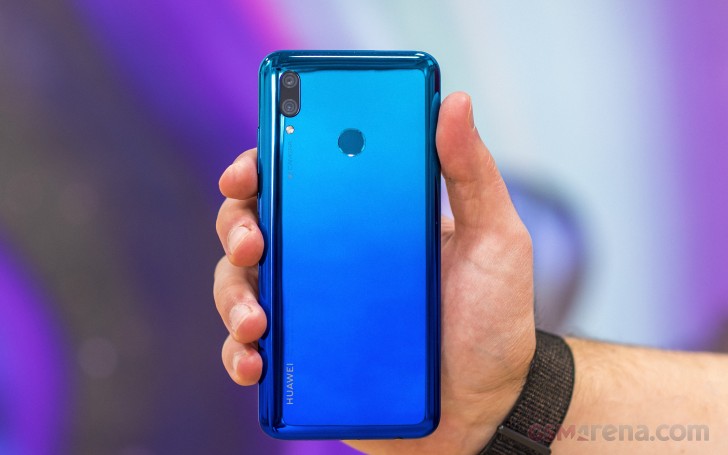
The back is home to the fingerprint sensor, a conventional placement towards the top. The dual camera is in the top left corner, the primary 13MP module and the 2MP depth sensor sharing a glass window. The single LED flash is below that in typical Huawei fashion and another customary but questionable design choice leaves us with an 'AI camera' inscription under the flash.
There's a prominent Huawei logo in the bottom left, plus some tiny text including the model name and country of origin, which is thankfully less in-your-face.
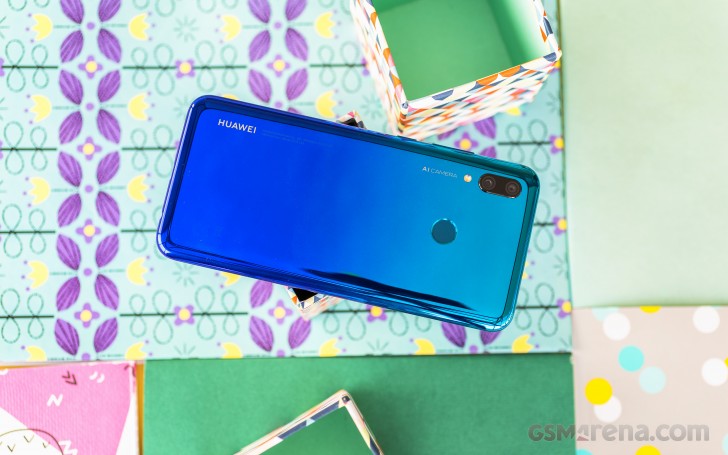
The 6.21-inch display takes up most of the front, as it should be with a panel that claims to be 'FullView'. There's a dewdrop selfie camera notch in the middle, one that reminds us a little of the Essential PH-1's - most other current designs are a bit more rounded and fluid.
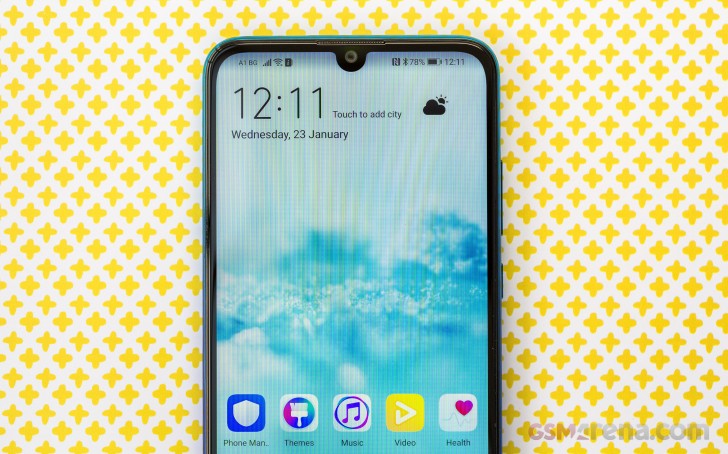
Right above the camera is the earpiece, nicely hidden where the front glass meets the plastic tub of the back panel. The bezel is equally thick on the sides and top, so folks that are irked by minor differences like these should be able to live with the P Smart 2019 just fine.
The bottom bezel is thicker, there's no going around that, but if high-end models haven't completely done away with it, we shouldn't expect it from the P Smart, of all phones. The chin does hold a pleasant surprise - a status LED is hidden in there, slightly to the left. It's RGB and lights up in amber when charging and pulsates in green for notifications.
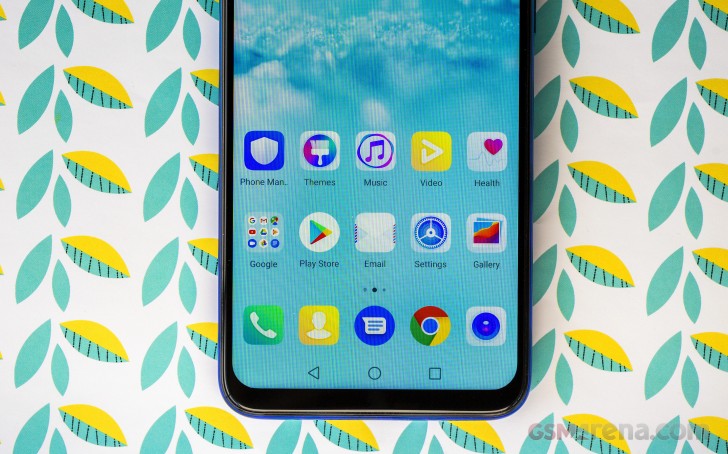
The physical controls are the usual power button and volume rocker, both on the right side of the phone. The power button is placed slightly above the midpoint and is textured - so it's where you'd expect to find it and it also can't be mistaken for the volume rocker.
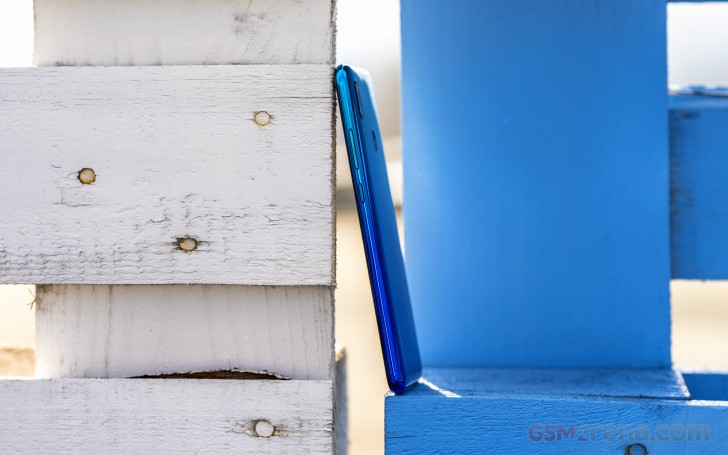
Down on the bottom is where you'll find one of Huawei's mistakes with the P Smart 2019 - it's got a microUSB port instead of USB-C, and that can't be right. The rest of the stuff you'd typically find in these quarters includes the loudspeaker, primary mic and 3.5mm headphone jack.
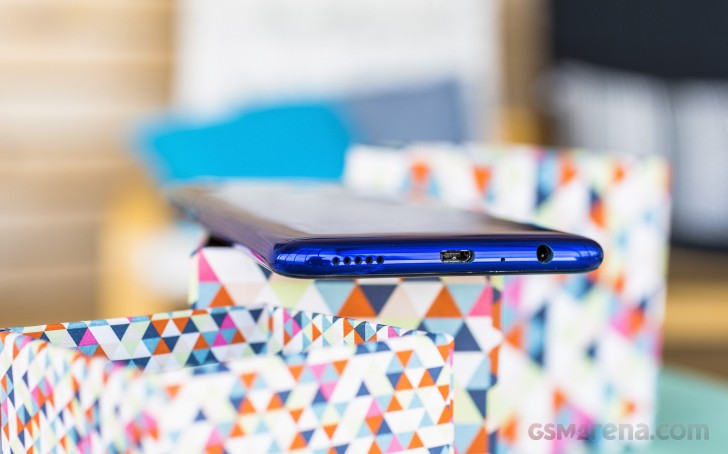
Another mic is on the opposite end of the phone. Here, it's joined by the card slot, which is the usual compromise - it's either two nano SIMS, or a nano SIM and a microSD card, but all three in there all at once. Sadly, dedicated memory slots aren't embraced by all makers.
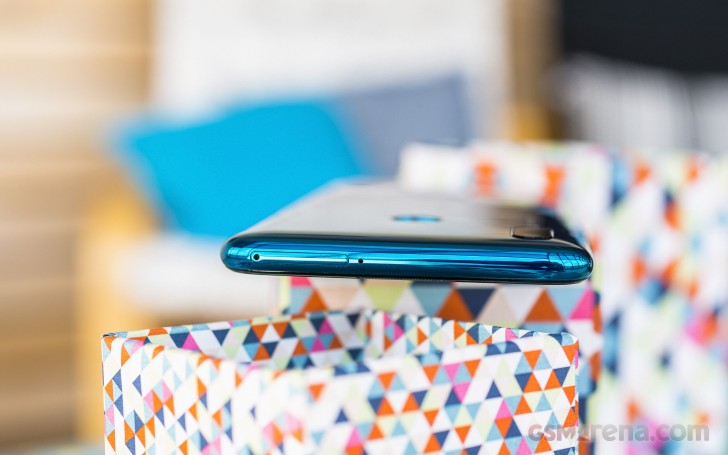
The P Smart 2019 has grown a little in physical size, but not nearly as much as the increase in display diagonal would suggest. The handset now measures 155.2x73.8x8.0mm - 5.1mm taller, 1.3mm wider and half a mil thicker than the model it replaces. It's more compact than competitors like the Realme 2 Pro and Redmi Note 6 Pro, with the Redmi in particular being tangibly wider at 76.4mm.
6.21 inches of accuracy, so-so brightness
The P Smart 2019 is equipped with a 6.21-inch IPS display with a dewdrop notch in the middle. It's got a tall aspect ratio of 19.5:9 and a 2340x1080px resolution for a pixel density of 415ppi - pretty standard numbers these days.
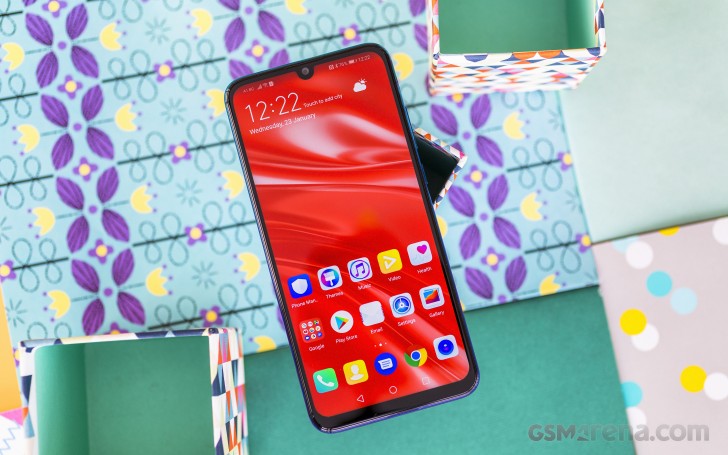
In our testing, the P Smart posted average results for brightness and contrast. There's no boost in auto mode, and the 430-something nits you can get in manual is the ceiling in auto as well. You can get more nits from some of the competition and the one phone in this bunch that does crank up the brightness in its auto mode, the Galaxy A7 (2018), is actually the brightest.
| Display test | 100% brightness | ||
| Black, cd/m2 | White, cd/m2 | ||
| 0.356 | 531 | 1492 | |
| 0.325 | 437 | 1345 | |
| 0.27 | 482 | 1785 | |
| 0.313 | 460 | 1470 | |
| 0.344 | 441 | 1282 | |
| 0 | 402 | ∞ | |
| 0 | 602 | ∞ | |
| 0.346 | 427 | 1234 | |
| 0.344 | 441 | 1282 | |
| 0.29 | 526 | 1814 | |
| 0.322 | 468 | 1453 | |
| 0.254 | 432 | 1701 | |
| 0.306 | 537 | 1755 | |
| 0.314 | 481 | 1532 | |
| 0 | 418 | ∞ | |
Under direct light, the P Smart 2019 fares decently and produces an average contrast score for its class. It's a noticeable improvement over the old model and it's also superior to the Honor 10 Lite, but the OLED displays of the Galaxy A7 (2018) and the vivo V11 will remain more easily legible out in the sun.
Sunlight contrast ratio
- Apple iPhone XS
5.171 - Apple iPhone X
5.013 - Huawei Mate 20 Pro
4.965 - OnePlus 5T
4.789 - Samsung Galaxy S8
4.768 - Asus ROG Phone
4.765 - Samsung Galaxy S8+
4.658 - Samsung Galaxy S9
4.63 - Samsung Galaxy S6 edge+
4.615 - Samsung Galaxy S9+
4.537 - Samsung Galaxy Note9
4.531 - Apple iPhone XS Max
4.516 - Sony Xperia XZ3
4.502 - Motorola Moto Z2 Play
4.459 - Oppo R11
4.454 - Samsung Galaxy S7 edge
4.439 - Oppo RX17 Pro
4.434 - OnePlus 3
4.424 - Samsung Galaxy S7
4.376 - Google Pixel 3
4.35 - Samsung Galaxy A7 (2018)
4.324 - OnePlus 6
4.321 - Xiaomi Mi Mix 3
4.291 - vivo NEX Dual Display (second display)
4.289 - HTC One A9
4.274 - LG V40 ThinQ
4.256 - Oppo R15 Pro
4.251 - Samsung Galaxy Note7
4.247 - Samsung Galaxy A3
4.241 - Nokia 8
4.239 - Google Pixel 2 XL (pre-update)
4.234 - OnePlus 3T
4.232 - Samsung Galaxy A9 (2018)
4.22 - Google Pixel XL
4.164 - ZTE Axon 7
4.154 - Samsung Galaxy Note8
4.148 - Meizu Pro 7 Plus
4.147 - OnePlus 6T
4.138 - Samsung Galaxy S6 edge
4.124 - Samsung Galaxy A7 (2017)
4.124 - vivo V11
4.113 - vivo NEX Dual Display
4.108 - Huawei Mate 10 Pro (normal)
4.096 - Samsung Galaxy Note5
4.09 - Huawei P20 Pro
4.087 - Xiaomi Mi 8
4.086 - Meizu 15
4.082 - Nokia 6 (2018)
4.052 - Google Pixel 2 (pre-update)
4.023 - LG V30
4.022 - Huawei Nexus 6P
4.019 - vivo NEX S
4.012 - Honor Magic 2
4.01 - Samsung Galaxy J7 Pro
3.998 - OnePlus X
3.983 - Vivo Xplay5 Elite
3.983 - LG G7 ThinQ (outdoor)
3.978 - Oppo R7s
3.964 - Apple iPhone 7
3.964 - Apple iPhone 8 (True Tone)
3.957 - Huawei P9 Plus
3.956 - Oppo Find X
3.954 - Meizu Pro 6 Plus
3.935 - Lenovo Moto Z
3.931 - Samsung Galaxy A7 (2016)
3.918 - OnePlus 5
3.914 - Samsung Galaxy C5
3.911 - Xiaomi Mi 8 SE
3.901 - Samsung Galaxy C7
3.896 - Samsung Galaxy A5
3.895 - Samsung Galaxy J7 outdoor
3.879 - Samsung Galaxy J2 outdoor
3.873 - Motorola Moto G6 Plus
3.865 - Samsung Galaxy A8
3.859 - Samsung Galaxy A8 (2018)
3.842 - Apple iPhone 6
3.838 - Microsoft Lumia 950XL
3.837 - Samsung Galaxy A6+ (2018)
3.834 - Sony Xperia XZs
3.818 - Samsung Galaxy A9 (2016)
3.817 - Motorola Moto X (2014)
3.816 - Samsung Galaxy J7 (2017)
3.812 - Samsung Galaxy A5 (2017)
3.804 - Samsung Galaxy J7 (2016) outdoor mode
3.802 - Xiaomi Redmi Pro
3.798 - LG V20 Max auto
3.798 - Sony Xperia XZ
3.795 - Samsung Galaxy A5 (2016)
3.789 - Apple iPhone 6s
3.783 - Meizu Pro 5
3.781 - Microsoft Lumia 650
3.772 - Xiaomi Mi 6
3.767 - Sony Xperia XZ1
3.765 - Samsung Galaxy J7 (2016)
3.756 - Nokia 8 Sirocco
3.745 - Sony Xperia XZ1 Compact
3.729 - Apple iPhone 8 Plus (True Tone)
3.725 - Oppo F1 Plus
3.709 - Vivo X5Pro
3.706 - Samsung Galaxy A3 (2017)
3.688 - Huawei P20
3.683 - Apple iPhone SE
3.681 - Huawei Mate 9
3.68 - Samsung Galaxy A7
3.679 - Sony Xperia XZ2 Compact
3.675 - Meizu PRO 6
3.659 - BlackBerry Priv
3.645 - Sony Xperia XA1 Ultra
3.597 - Apple iPhone 7 Plus
3.588 - Sony Xperia XZ2
3.58 - LG G6
3.556 - Apple iPhone 6s Plus
3.53 - Motorola Moto Z Play
3.526 - Samsung Galaxy J3 (2016)
3.523 - Samsung Galaxy J3 (2016) outdoor mode
3.523 - Acer Jade Primo
3.521 - Microsoft Lumia 950
3.512 - Oppo R7 Plus
3.499 - Nokia 7 plus
3.479 - nubia Z11
3.466 - Huawei P10 Plus
3.456 - HTC U Ultra
3.453 - Motorola Moto G6
3.448 - Sony Xperia XA2 Ultra
3.445 - Sony Xperia XA2 Plus
3.445 - Samsung Galaxy J7
3.422 - Motorola Moto G6 Play
3.419 - Meizu MX5
3.416 - LG V20
3.402 - Samsung Galaxy A6 (2018)
3.397 - Xiaomi Redmi Note 5 AI Dual Camera
3.393 - LG G7 ThinQ
3.39 - Huawei P10
3.379 - Samsung Galaxy J5 (2016)
3.378 - Oppo R9s
3.352 - Honor Play
3.349 - Honor 8 Pro
3.341 - Oppo F7
3.333 - Oppo R7
3.32 - Lenovo P2
3.316 - Archos Diamond Omega
3.305 - Honor 9
3.289 - Xiaomi Mi 5s
3.276 - Nokia 5
3.261 - Nokia 6 (Chinese version)
3.244 - Xiaomi Mi 5
3.24 - Nokia 6 (Global version)
3.238 - Samsung Galaxy J2
3.235 - Oppo Realme 2 Pro
3.235 - Sony Xperia X Performance
3.234 - Xiaomi Mi Note 2
3.228 - Motorola Moto X Play
3.222 - Oppo F3 Plus
3.218 - BlackBerry KEY2
3.212 - Huawei Mate 9 Pro
3.206 - Huawei P9
3.195 - Xiaomi Mi Mix 2
3.19 - ZTE Nubia Z17
3.159 - Oppo R11s
3.153 - Lenovo Vibe Shot
3.113 - Honor 8X
3.113 - HTC U11 Life
3.108 - Motorola Moto X Force
3.105 - LG Nexus 5X
3.092 - HTC U11
3.089 - Xiaomi Mi A2 Lite
3.087 - HTC U12+
3.085 - Xiaomi Redmi S2 (Y2)
3.077 - Huawei Mate S
3.073 - Huawei P Smart 2019
3.069 - Oppo F9
3.069 - Microsoft Lumia 640 XL
3.065 - Xiaomi Mi Max 3
3.061 - Xiaomi Pocophone F1
3.059 - Huawei Mate 20
3.052 - Huawei Mate 20 Lite
3.051 - Motorola One (P30 Play)
3.026 - Apple iPhone 6 Plus
3.023 - Asus Zenfone 4 ZE554KL
3.019 - Sony Xperia XA1
3.012 - Motorola Moto X4
3.012 - Oppo Realme 2
3.006 - Sony Xperia L1
2.994 - Sony Xperia X
2.989 - LG Q6
2.987 - Huawei P10 Lite
2.974 - Samsung Galaxy Note
2.97 - Xiaomi Redmi Note 6 Pro
2.966 - Huawei P20 Lite
2.952 - Xiaomi Redmi 5
2.951 - Huawei Mate 8
2.949 - Sony Xperia XA2
2.938 - Oppo Realme 1
2.932 - Razer Phone 2
2.932 - Xiaomi Redmi 4
2.92 - Xiaomi Redmi 3S
2.913 - Xiaomi Redmi 5 Plus
2.913 - Sony Xperia XA Ultra
2.906 - LG G5
2.905 - Huawei Honor View 10
2.896 - Xiaomi Redmi 3s Prime
2.893 - Xiaomi Mi 5s Plus
2.884 - Sony Xperia XZ Premium (sRGB)
2.877 - Sony Xperia XZ Premium
2.877 - Sony Xperia Z5
2.876 - Nokia 3
2.871 - Sony Xperia XZ2 Premium
2.867 - Xiaomi Mi 8 Lite
2.862 - Microsoft Lumia 550
2.851 - Nokia 3.1
2.837 - Realme U1
2.815 - Lenovo Moto M
2.813 - Nokia 7.1
2.804 - Xiaomi Redmi 3 Pro
2.803 - Sony Xperia Z5 compact
2.784 - Honor 10 (Vivid)
2.757 - Nokia 2
2.752 - Meizu MX6
2.751 - LG V10
2.744 - Huawei Mate 10 (normal)
2.742 - Motorola Moto G5S Plus
2.737 - Xiaomi Redmi 3
2.735 - Huawei Honor 7X
2.734 - Xiaomi Redmi Note 4 (S625)
2.714 - Meizu M5
2.71 - Xiaomi Mi A2
2.696 - Sony Xperia M5
2.69 - Xiaomi Mi A1
2.689 - Huawei P9 Lite
2.679 - Xiaomi Redmi 4 Prime
2.679 - vivo V7+
2.671 - Vivo V3Max
2.659 - Xiaomi Mi Mix
2.658 - Huawei Mate 10 Lite
2.654 - Oppo F5
2.653 - Doogee Mix
2.642 - Xiaomi Mi 4i
2.641 - Xiaomi Redmi 4a
2.635 - Sony Xperia Z3
2.618 - Xiaomi Mi 5X (Standard)
2.616 - Sony Xperia XA
2.609 - Motorola Moto G4 Plus
2.582 - Motorola Moto G4 Plus (max auto)
2.582 - Meizu M5s
2.58 - Xiaomi Mi 4c
2.574 - LeEco Le Max 2
2.567 - Microsoft Lumia 640
2.563 - Asus Zenfone 3 ZE552KL
2.563 - Huawei P Smart
2.563 - Xiaomi Mi Max 2
2.561 - HTC U11+
2.556 - Xiaomi Redmi Note 5A (Y1)
2.556 - Lenovo Moto G4
2.544 - Lenovo K6 Note
2.544 - Oppo F1
2.528 - Sony Xperia Z5 Premium
2.525 - Huawei Honor 7 Lite / Honor 5c
2.506 - Sony Xperia M4 Aqua
2.503 - Huawei Honor 10 Lite
2.497 - BlackBerry Motion
2.494 - Oppo F1s
2.481 - Motorola Moto G
2.477 - Lenovo Vibe K5 Plus
2.473 - Huawei G8
2.471 - Huawei nova
2.467 - Sony Xperia Z
2.462 - Lenovo Vibe K5
2.459 - Meizu m3 max
2.447 - Xiaomi Mi 5X (Auto)
2.417 - HTC 10 evo
2.407 - Huawei Honor 7
2.406 - Vivo V7
2.404 - Sony Xperia E5
2.386 - ZUK Z1 by Lenovo
2.382 - HTC 10
2.378 - Oppo F3
2.376
We've been saving the best bit for last - the P Smart 2019 can be spectacularly accurate in representing the sRGB color space. In the Normal+Default display setting it achieves an average DeltaE of 1.2 but a slight tweak with the color wheel brings that down to a negligible 0.6.
Of course, that's not the default mode, because people tend to prefer livelier colors. The Vivid+Default setting (the actual out-of-the-box state) delivers those, but it also renders slightly bluish whites though it still manages a decent average DeltaE of 5.5 when compared against an sRGB target.
Huawei P Smart 2019 battery life
The P Smart 2019 packs a 3,400mAh battery, up from the 3,000mAh of last year's model. It does have a larger display area to light up, to the tune of 15%, which is that extra bit more than the bump in capacity.
The newer and more efficient chipset played its role too, and this year's model showed vastly improved endurance in standby and 3G voice calls, slight increase in video playback longevity and a minor (within the margin of error) decrease in Wi-Fi web browsing. Neither screen-on test returned spectacular numbers, but 10 hours of looping our web script and 11 hours of video playback are quite reasonable results. Overall, the P Smart 2019's Endurance rating works out to 88 hours - a tangible 15-hour improvement over the predecessor.

Our battery tests were automated thanks to SmartViser, using its viSer App. The endurance rating above denotes how long a single battery charge will last you if you use the Huawei P Smart 2019 for an hour each of telephony, web browsing, and video playback daily. We've established this usage pattern so that our battery results are comparable across devices in the most common day-to-day tasks. The battery testing procedure is described in detail in case you're interested in the nitty-gritty. You can check out our complete battery test table, where you can see how all of the smartphones we've tested will compare under your own typical use.
We were gearing for some heavy ranting after we saw the plain 5V/2A charger, but in reality it filled an empty battery in 1:42h which isn't too shabby. Sure, the 36% we got after a 30-minute stint isn't mind-blowingly fast, but the whole charging experience wasn't really rant-worthy.
Loudspeaker
The P Smart 2019 has the one loudspeaker - a classic bottom-firing one next to the charging port. It's plenty loud and won't leave ringtones unnoticed, but using it for any sort of music playback is likely to disappoint you due to some clipping at high volume and distinct lack of punch in the low frequencies.
| Speakerphone test | Voice, dB | Ringing |
Overall score | |
| 68.3 | 73.8 | 75.8 | Good | |
| 66.5 | 72.0 | 79.8 | Good | |
| 67.5 | 71.3 | 79.7 | Good | |
| 69.4 | 70.9 | 79.9 | Very Good | |
| 67.1 | 72.9 | 81.6 | Very Good | |
| 67.8 | 70.0 | 84.2 | Very Good | |
| 65.9 | 70.8 | 85.8 | Very Good | |
| 66.3 | 71.5 | 84.9 | Very Good | |
| 67.5 | 77.8 | 77.6 | Very Good | |
| 70.7 | 73.8 | 80.7 | Very Good | |
| 69.1 | 74.8 | 81.4 | Very Good | |
| 71.7 | 74.4 | 81.6 | Very Good | |
| 70.1 | 73.1 | 85.4 | Excellent | |
| 69.5 | 73.6 | 86.0 | Excellent | |
| 70.0 | 73.8 | 87.0 | Excellent | |
| 75.6 | 76.0 | 81.1 | Excellent |
Audio quality
The Huawei P Smart 2019 had above average loudness with an active external amplifier and excellent scores across the board, which was a very promising start.
Unfortunately, headphones did quite a lot of damage - volume dropped to way below average, frequency response got somewhat shaky and some intermodulation distortion crept in. Stereo crosstalk increased by an above average amount too, adding up to a rather mediocre performance in the more important part of the test.
| Test | Frequency response | Noise level | Dynamic range | THD | IMD + Noise | Stereo crosstalk |
| +0.02, -0.02 | -93.1 | 93.0 | 0.0039 | 0.0088 | -81.9 | |
| +0.64, -0.38 | -88.6 | 91.9 | 0.0069 | 0.606 | -50.6 | |
| +0.04, -0.04 | -93.5 | 93.4 | 0.0011 | 0.0070 | -93.4 | |
| +0.45, -0.18 | -93.4 | 93.4 | 0.021 | 0.457 | -54.9 | |
| +0.01, -0.04 | -92.3 | 92.4 | 0.0041 | 0.0085 | -80.7 | |
| +0.45, -0.54 | -92.2 | 92.8 | 0.0084 | 0.492 | -51.5 | |
| +0.02, -0.02 | -93.1 | 92.9 | 0.0026 | 0.0089 | -92.5 | |
| +0.25, -0.17 | -91.4 | 91.6 | 0.115 | 0.306 | -55.4 | |
| +0.02, -0.06 | -91.0 | 88.6 | 0.0021 | 0.016 | -94.4 | |
| +0.05, -0.03 | -93.8 | 89.6 | 0.0019 | 0.034 | -54.9 |
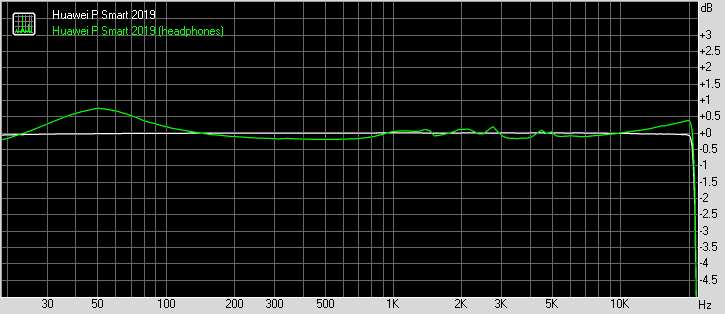
Huawei P Smart 2019 frequency response
You can learn more about the tested parameters and the whole testing process here.
Android 9.0 Pie with EMUI 9 on top
The P Smart 2019 boots Android 9 Pie with Huawei's own EMUI bolted on top, itself version 9 as well. As it stands, the smartphone is one of not all that many midrangers to run Google's latest, so that goes in our Pros list at the end of the review.
Like all EMUI-driven devices, you can set up a magazine lockscreen style that changes the picture every time you wake up the screen. Sliding from the bottom will bring out quick shortcuts to some commonly used utilities. As usual, we found it to be useful and a bit annoying at the same time because there were times when we just wanted to unlock the phone but we brought out the menu instead.
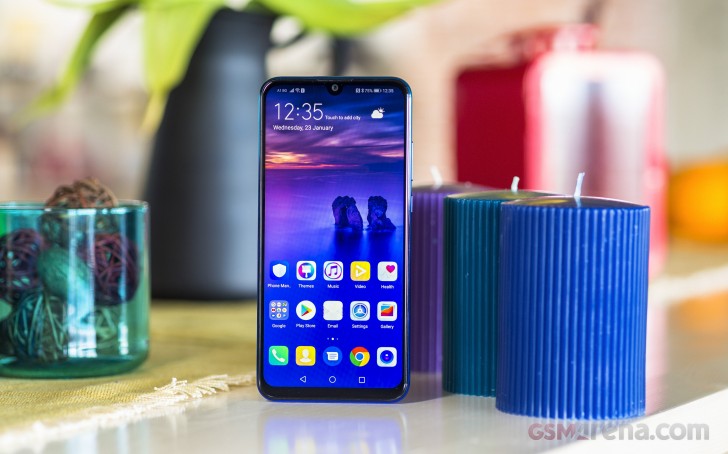
On the homescreen you will find all of the installed and system apps but there's a toggle in the settings menu that lets you choose between the standard layout or a homescreen with an app drawer. It's a personal preference and it's good to be able to choose.






Lockscreen • Tools • Magazine unlock • Homescreen • Homescreen style • Folder view
Swiping to the right from the homescreen will bring up your Google Feed while swiping down from an empty area lets you search in your apps and contacts. On other makers' launchers that last action could bring down the notification shade, but not here.
You can, however, pull down the shade by swiping on the fingerprint reader, then double tap to dismiss all notifications and swipe back up to hide the shade - no more reaching for the top bezel when using this tall 19.5:9 screen. This is a setting that you need to enable in the fingerprint ID section of the settings menu, it's not on by default.
The notification shade itself is nothing out of the ordinary. It can fit three rows with five quick launch icons for each row and right under the icons, you will find the screen brightness slider.
The notch on the P Smart may be minimal, but you still get the option to hide it altogether by painting the entire status bar black. Curiously, Huawei hasn't bothered customizing the visualization in settings to match the P Smart's notch, but if that lets them put our Pie before the rest, so be it.






Google Feed • App/contacts search • Notification shade • Fingerprint reader swipe gesture • Notch settings
As we've seen on other recent Huawei/Honor devices, on the P Smart 2019 you can opt for gesture based navigation if the classic navbar is too 2018 for you. It goes like this - swipe up for Home, swipe up and stop midway for Task switcher, or swipe from the left or right edge of the screen for Back.
From the Phone Manager app, you can access shortcuts to storage cleanup, battery settings, blocked numbers, Virus scan powered by Avast, and mobile data usage.
Huawei's own Music app offers a way to listen to stored MP3s, while Huawei's Health app offers Google Fit syncing and step counting. The gallery is an entirely custom job too, but it has the usual chronological and albums views plus an AI powered highlights selection. There's a file manager app and a note-taking app. And if you don't like any of those - there is an abundance of alternatives in the Play Store.




Phone Manager • Music Player • Gallery • Files
The "Security and privacy" menu lets you set up a fingerprint, enable face detection, set up "Find My Device" option, etc. The fingerprint enrollment process is pretty straightforward and the phone will instruct you which parts of your digit you need to rescan if you didn't do it quite right the first time. Subsequent recognition is excellent as well, though it does take an extra fraction of a second more to unlock than we're used to - it's not slow by any means, but we've been spoiled.
Face recognition is available as well and there's an option in there that enables instant unlock when it detects your face or requires a slide before unlocking.
Performance and benchmarks
The P Smart 2019 is powered by the in-house mid-range SoC, the HiSilicon Kirin 710, made on a 12nm process. It packs an octa-core CPU in a 4+4 configuration - 4 big 2.2 GHz Cortex-A73 cores and 4 smaller 1.7 GHz Cortex-A53 cores. The GPU is Mali-G51 MP4. Our review unit comes with 3GB of RAM and 64GB of storage, but a 32GB version is also available (with the same 3gigs of RAM).
As was the case with the Honor 10 Lite, the P Smart 2019 wouldn't cooperate and we couldn't install any benchmarks on it. We have tested the Mate 20 Lite and the Honor 8X with the same chipset, so you can turn to those to get the ballpark of the benchmark scores you can expect from the P Smart. Both of those devices were running Android 8.1 Oreo, while the P Smart and Honor 10 Lite boot Pie, so we're seeing a pattern, but we don't know what to make of it.
13MP + 2MP rear shooter
The P Smart 2019 comes with a similar camera setup to the one on last year's model - a 13MP primary module with an extra 2MP sensor just for depth detection. The main unit has gotten an improved lens and now has an f/1.8 aperture as opposed to f/2.2, but that's about it.
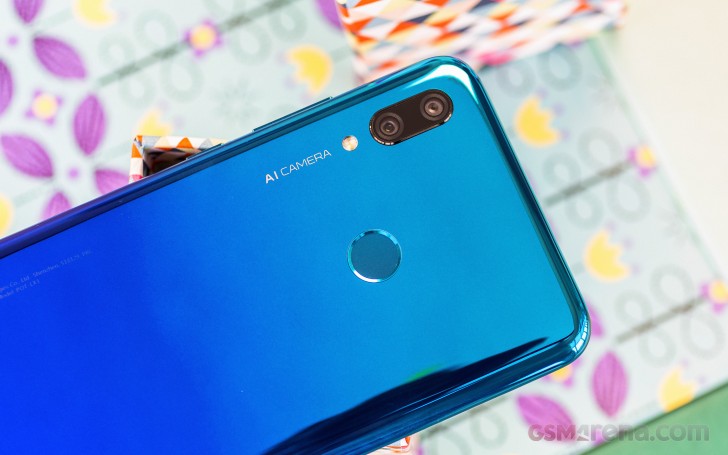
There is, of course, autofocus, and it's based on phase detection, while a single LED flash is there to throw some light at very dark scenes. There's no optical stabilization, which isn't a huge surprise.
Naturally, there's AI powered scene recognition, which will recognize 22 categories of scenes and adjust image parameters accordingly. The real-life effect, as a general rule, is pumped up contrast and heavily boosted colors. The good thing is that there's an easily accessible toggle in the viewfinder so you can enable/disable it without delving into settings.
Other than that, camera app would be familiar to anyone who's picked up a recent Huawei smartphone, which means it's messy and scattered as usual. You have a mode selector on the bottom that you swipe left and right to change modes, but you can't swipe on the viewfinder, just on the selector itself. Swiping up and down doesn't switch between front and rear camera either, you have a button for that (admittedly, on the bottom within easy reach). One would think that touchscreen navigation should be more than just tapping on software buttons. Well, there is pinch to zoom.
There's a host of special modes in the 'More' section on the selector, including Panorama, Light painting, HDR and Pro. Since you may not want to have AI on all the time, having a dedicated HDR mode is nice to have for those extra contrasty scenes when you might want the added dynamic range.



General Photo mode • AI enabled • HDR is a separate mode
In the Pro mode you can adjust parameters yourself - ISO (50 to 1600), shutter speed (1/4000s to 8s), exposure compensation (-4 to +4EV in 1/3 stop increments), and white balance (presets and light temperature). You can also choose the metering mode (matrix, center-weighted and spot), and the focus mode (single, continuous and manual). If the phone thinks you messed up the exposure, an icon will pop up to warn you.
As we've come to expect from Huawei phones, the P Smart 2019 has both a Portrait mode and an Aperture mode. In Aperture, you can choose the simulated aperture in the range from f/0.95 to f/16. Post shot, you can change the aperture and the focus point within the Gallery.
In Portrait mode you can enable and disable the background blur (why disable it, though?), you can change the simulated lighting, and you can also add some beautification on a scale from 0 to 10.



Pro mode • Portrait mode *Aperture mode
In the not so photographic, but fun section, there's the AR lens mode with Huawei's Qmoji in there. You can choose between a number of different characters and create a gif of yourself making funny faces. Alternatively, you could place yourself in front a landmark with a filter applied to match the vibe of the particular spot (and also mask the fact that you're not really there).
Image quality
In daylight, the P Smart 2019 takes okay photos for its class. Detail is decent and about what you'd expect from a 13MP sensor plus it's a step up from the previous model. Contrast has been slightly improved too. There's a noticeable refinement in noise performance, though admittedly the older P Smart didn't set the bar too high with its noisy skies.
Colors are reasonably vivid without being over the top, but the reds are way off towards magenta. Dynamic range is nothing spectacular, but not bad either, considering the class.









Camera samples, daylight, AI disabled
Turning on AI results in only the smallest of differences, particularly in scenes with a lot of sky in them, but even then it's not the dramatic oversaturation we saw on early Huawei aI implementations. What is significantly different is the resolution - AI shots are 8MP as opposed to 13MP.






Camera samples, daylight, AI enabled
Similarly, HDR mode doesn't make a world of a difference. You can expect to have some highlight recovery and virtually identical shadows in high-contrasty scenes, when comparing to images taken in the regular Photo mode.






Camera samples, daylight, HDR mode
Lowlight performance is just barely passable with images taken in Photo come coming out noticeably soft and noisy. Color preservation is decent, at least. If you opt for the AI mode and it selects a Night scene (it randomly picked Portrait every now and then), you'd get improved sharpness, but again - lower resolution at 8MP.




Camera samples, low light, AI disabled




Camera samples, low light, AI enabled
The dedicated Night mode with its pseudo long exposures is that extra bit sharper, plus it does keep highlights from blowing out thus retaining detail in there as well. Even though it's not as magical as on Huawei flagships, it is your best bet for night time shots on the P Smart 2019.




Camera samples, low light, Night mode
Once you're done examining the real-life samples you can have a look at our Photo compare tool for some studio shots. We've pre-selected the Galaxy A7 (2018) and the Realme 2 Pro but you can pick any other set of phones to compare once you're there.



Huawei P Smart 2019 against the Galaxy A7 (2018) and the Realme 2 Pro in our Photo compare tool
It's common practice with more affordable phones to pack a low-res secondary cam just for depth detection and such is the case with the P Smart 2019. Business as usual, this model too has both a Portrait mode and an Aperture mode.
In both modes, the resulting shots are 8MP, unlike other Huaweis where we've gotten full-res Portraits, and lower-res Aperture shots. Subject isolation with humans in Portrait mode is pretty good, though a particular set of circumstances will fool the algorithms, as usual. Our customary advice stands - take multiple shots, varying slightly the angles, and that will give you a higher likelihood of ending up with a convincing portrait.
What we observed is that you need plenty of light for a sharp portrait - anything less than ideal light and images end up blurry.
In aperture mode you get to pick the simulated aperture between f/0.95 and f/16. It's also your only option for isolating non-human subjects as Portrait mode doesn't work on them.
8MP selfies
The P Smart 2019 comes with either an 8MP or a 16MP selfie camera depending on the market. Our review unit has the 8MP one. Our biggest beef with the selfies here is perhaps the fact that switching to the front camera defaults to the Portrait mode, instead of the general Photo.
Portraits look alright with generally good subject detection. There's only the slightest detail penalty when shooting in Portrait as opposed to Photo. Enabling AI results in a certain boost of saturation depending on which scene it chooses - the first one on the bottom was taken with optimizations for Room, the second wasn't recognized at all.




Selfie samples, Portrait mode: AI off • AI on • AI off • AI on
Selfies in Photo mode turn out good as well, with the focus fixed at the correct distance for arm's length shots. Skin tones are nice as are colors in general. AI tends to brighten up exposures to make facial imperfections less visible.




Selfie samples, Photo mode: AI off • AI on • AI off • AI on
Video recording
The P Smart 2019 records video at up to 1080p resolution - Huawei's Kirin 710 can't do the number crunching for 2160p capture. 1080p can be shot in either 30fps or 60fps. There's no electronic stabilization, not even in 30fps, making run and gun footage extremely jerky.
Video is encoded using the h.264 codec by default with a toggle to switch to h.265 if you so wish. That said, the bit rates with h.264 are more in line with what you'd get with the more efficient h.265 from other phones - 1080p/30fps videos get around 10.8Mbps, while 1080p/60fps is treated to about 17Mbps. Audio is always stereo, recorded at 192kbps.
1080p/30fps footage is decently detailed, particularly for comparatively low bit rate. Contrast is a bit too much, however, resulting in much too dark shadows. Color rendition is on point, with the reds actually looking deeper and truer than in stills.
The last stop is, of course, our Video compare tool where you can compare the P Smart 2019's output against other phones we've tested. We've pre-selected the Galaxy A7 (2018) and the Realme 2 Pro, but a different set of devices is only a few clicks away.



Huawei P Smart 2019 against the Galaxy A7 (2018) and the Realme 2 Pro in our Video compare tool
Competition
Competent midragners are no longer the unicorns they once were and there's plenty of choice if you're not after the absolute best on the market and are willing to save some bucks. They usually have bright displays, solid battery life, and decent cameras, and it's often tough to pick one just on the merits. They're often simply just good enough.




Samsung Galaxy A7 (2018) • Realme 2 Pro • Xiaomi Redmi Note 6 Pro • Oppo F9 (F9 Pro)
You could say the Samsung Galaxy A7 (2018) stands out thanks to its ultra wide camera - those are still close to unicorn status in this segment, and the P Smart certainly doesn't have one. Overall image quality isn't significantly better on either phone, however. The A7's got longer battery life than the P Smart, but is even slower to charge. Its AMOLED display can go significantly brighter and is superior in the sun, but nothing can beat the P Smart for absolute sRGB accuracy (if that's at all on someone's list of top priorities). The P Smart's Kirin 710 is more powerful than the Exynos 7885 in the Galaxy, plus the Huawei phone has the newest Android unlike the A7.
The Realme 2 Pro is still on 8.1 Oreo too, so it's behind the P Smart 2019 on this one. Battery life is comparable as is charging speed, and the Realme is only slightly better in the display department (except for accuracy, where as we established the P Smart 2019 is king). Where the Realme is consistently better is image quality, day and night, front and back. And going into video, it offers the added bonus of 4K capture and stabilization in 1080p, both of which the P Smart lacks.

Next up is the Redmi Note 6 Pro which also outclasses the P Smart 2019 in the stills department plus it offers video EIS in 1080p (no 4K on the Redmi either). The Xiaomi phone's Snapdragon 636 isn't as brawny as the Kirin 710, and the OS is the older Oreo, but battery life and display quality is in the same ballpark.
One of the best-aging midrangers of last year, the Nokia 7 Plus, is worth a mention here. It's gotten its Pie update so it's on level terms with the P Smart in this respect, and that's pretty much the case in battery life. It's got a proper telephoto camera to pit against the P Smart's depth sensor, it can record 4K video and it has stabilization in 1080p. The Nokia's got the more premium build too, but it also costs a bit more.
Verdict
The P Smart 2019 has a display that stands out with chart-topping accuracy but is distinctly good enough in other respects. Battery life is solid and charging speed isn't as slow as the pedestrian adapter would have suggested. Image quality is not flagship grade, but it'll do. It runs the latest OS in a world of generally outdated software. And all of this comes at a very reasonable price, which is often sweetened further by carrier subsidies. What's not to like?
Well, the all-plastic build isn't the most durable. Or rather, it may live to survive a drop better than glass, but it gets scuffed up more easily. A microUSB port has no place on a phone with '2019' in its name. And then the lack of any video stabilization is hard to swallow, plus some competitors can even record 4K video, and the P Smart 2019 maxes out at 1080p.
Carefully weighing the lists below, while also keeping in mind the price, it's looking like the Huawei P Smart 2019 is one of those affordable all-rounders that are often the, ahem... smart choice.
Pros
- Very light for its display size and battery capacity.
- Two-tone color scheme a joy to look at.
- Good battery life.
- Display capable of superb accuracy.
- One of few midrangers with Android Pie.
Cons
- Prone to scratching.
- microUSB port is a thing of the past.
- No video stabilization and no 4K recording.
























0 Response to "Huawei P Smart 2019 review"
Post a Comment